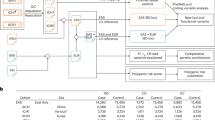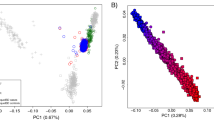Abstract
Background
Crohn’s disease (CD) and ulcerative colitis (UC) are two major forms of inflammatory bowel disease (IBD). Meta-analyses of genome-wide association studies (GWAS) have identified 163 susceptibility loci for IBD among European populations; however, there is limited information for IBD susceptibility in a Japanese population.
Methods
We performed a GWAS using imputed genotypes of 743 IBD patients (372 with CD and 371 with UC) and 3321 controls. Using 100 tag single-nucleotide polymorphisms (SNPs) (P < 5 × 10−5), a replication study was conducted with an independent set of 1310 IBD patients (949 with CD and 361 with UC) and 4163 controls. In addition, 163 SNPs identified by a European IBD GWAS were genotyped, and genetic backgrounds were compared between the Japanese and European populations.
Results
In the IBD GWAS, two East Asia-specific IBD susceptibility loci were identified in the Japanese population: ATG16L2–FCHSD2 and SLC25A15–ELF1–WBP4. Among 163 reported SNPs in European IBD patients, significant associations were confirmed in 18 (8 CD-specific, 4 UC-specific, and 6 IBD-shared). In Japanese CD patients, genes in the Th17–IL23 pathway showed stronger genetic effects, whereas the association of genes in the autophagy pathway was limited. The association of genes in the epithelial barrier and the Th17–IL23R pathways were similar in the Japanese and European UC populations.
Conclusions
We confirmed two IBD susceptibility loci as common for CD and UC, and East Asian-specific. The genetic architecture in UC appeared to be similar between Europeans and East Asians, but may have some differences in CD.

Similar content being viewed by others
References
Podolsky DK. Inflammatory bowel disease. N Engl J Med. 2002;347:417–29.
Halme L, Paavola-Sakki P, Turunen U, et al. Family and twin studies in inflammatory bowel disease. World J Gastroenterol. 2006;12:3668–72.
Tysk C, Lindberg E, Järnerot G, et al. Ulcerative colitis and Crohn’s disease in an unselected population of monozygotic and dizygotic twins. A study of heritability and the influence of smoking. Gut. 1988;29:990–6.
Franke A, McGovern DPB, Barrett JC, et al. Genome-wide meta-analysis increases to 71 the number of confirmed Crohn’s disease susceptibility loci. Nat Genet. 2010;42:1118–25.
Anderson CA, Boucher G, Lees CW, et al. Meta-analysis identifies 29 additional ulcerative colitis risk loci, increasing the number of confirmed associations to 47. Nat Genet. 2011;43:246–52.
Jostins L, Ripke S, Weersma RK, et al. Host–microbe interactions have shaped the genetic architecture of inflammatory bowel disease. Nature. 2012;491:119–24.
Asakura K, Nishiwaki Y, Inoue N, et al. Prevalence of ulcerative colitis and Crohn’s disease in Japan. J Gastroenterol. 2009;44:659–65.
Goh K, Xiao S-D. Inflammatory bowel disease: a survey of the epidemiology in Asia. J Dig Dis. 2009;10:1–6.
Molodecky NA, Soon IS, Rabi DM, et al. Increasing incidence and prevalence of the inflammatory bowel diseases with time, based on systematic review. Gastroenterology. 2012;142:46–54.
Yamazaki K, McGovern D, Ragoussis J, et al. Single nucleotide polymorphisms in TNFSF15 confer susceptibility to Crohn’s disease. Hum Mol Genet. 2005;14:3499–506.
Yamazaki K, Umeno J, Takahashi A, et al. A genome-wide association study identifies 2 susceptibility loci for Crohn’s disease in a Japanese population. Gastroenterology. 2013;144:781–8.
Yang S-K, Hong M, Zhao W, et al. Genome-wide association study of Crohn’s disease in Koreans revealed three new susceptibility loci and common attributes of genetic susceptibility across ethnic populations. Gut. 2014;63:80–7.
Yang S, Hong M, Choi H, et al. Immunochip analysis identification of 6 additional susceptibility Loci for Crohn’s disease in Koreans. Inflamm Bowel Dis. 2015;21:1–7.
Asano K, Matsushita T, Umeno J, et al. A genome-wide association study identifies three new susceptibility loci for ulcerative colitis in the Japanese population. Nat Genet. 2009;41:1325–9.
Yang S-K, Hong M, Zhao W, et al. Genome-wide association study of ulcerative colitis in Koreans suggests extensive overlapping of genetic susceptibility with Caucasians. Inflamm Bowel Dis. 2013;19:954–66.
Franke A, Balschun T, Karlsen TH, et al. Sequence variants in IL10, ARPC2 and multiple other loci contribute to ulcerative colitis susceptibility. Nat Genet. 2008;40:1319–23.
Silverberg MS, Cho JH, Rioux JD, et al. Ulcerative colitis-risk loci on chromosomes 1p36 and 12q15 found by genome-wide association study. Nat Genet. 2009;41:216–20.
Okada Y, Yamazaki K, Umeno J, et al. HLA-Cw*1202-B*5201-DRB1*1502 haplotype increases risk for ulcerative colitis but reduces risk for Crohn’s disease. Gastroenterology. 2011;141:864–71.
Kiyohara Y, Kubo M, Kato I, et al. Ten-year prognosis of stroke and risk factors for death in a Japanese community: the Hisayama study. Stroke. 2003;34:2343–7.
Hirano A, Yamazaki K, Umeno J, et al. Association study of 71 European Crohn’s disease susceptibility loci in a Japanese population. Inflamm Bowel Dis. 2013;19:526–33.
Abecasis GR, Auton A, Brooks LD, et al. An integrated map of genetic variation from 1,092 human genomes. Nature. 2012;491:56–65.
Li Y, Willer CJ, Ding J, et al. MaCH: using sequence and genotype data to estimate haplotypes and unobserved genotypes. Genet Epidemiol. 2010;34:816–34.
Barrett JC, Fry B, Maller J, et al. Haploview: analysis and visualization of LD and haplotype maps. Bioinformatics. 2005;21:263–5.
Ohnishi Y, Tanaka T, Ozaki K, et al. A high-throughput SNP typing system for genome-wide association studies. J Hum Genet. 2001;46:471–7.
Purcell S, Neale B, Todd-Brown K, et al. PLINK: a tool set for whole-genome association and population-based linkage analyses. Am J Hum Genet. 2007;81:559–75.
Pruim RJ, Welch RP, Sanna S, et al. LocusZoom: regional visualization of genome-wide association scan results. Bioinformatics. 2010;26:2336–7.
Purcell S, Cherny SS, Sham PC. Genetic Power Calculator: design of linkage and association genetic mapping studies of complex traits. Bioinformatics. 2003;19:149–50.
Khor B, Gardet A, Xavier RJ. Genetics and pathogenesis of inflammatory bowel disease. Nature. 2011;474:307–17.
Arimura Y, Isshiki H, Onodera K, et al. Characteristics of Japanese inflammatory bowel disease susceptibility loci. J Gastroenterol. 2014;49:1217–30.
Liu JZ, van Sommeren S, Huang H, et al. Association analyses identify 38 susceptibility loci for inflammatory bowel disease and highlight shared genetic risk across populations. Nat Genet. 2015;47:979–86.
De Bakker PIW, McVean G, Sabeti PC, et al. A high-resolution HLA and SNP haplotype map for disease association studies in the extended human MHC. Nat Genet. 2006;38:1166–72.
Hugot J, Chamaillard M, Zouali H, et al. Association of NOD2 leucine-rich repeat variants with susceptibility to Crohn’s disease. Nature. 2001;411:599–603.
Hampe J, Franke A, Rosenstiel P, et al. A genome-wide association scan of nonsynonymous SNPs identifies a susceptibility variant for Crohn disease in ATG16L1. Nat Genet. 2007;39:207–11.
Parkes M, Barrett JC, Prescott NJ, et al. Sequence variants in the autophagy gene IRGM and multiple other replicating loci contribute to Crohn’s disease susceptibility. Nat Genet. 2007;39:830–2.
Ogura Y, Bonen DK, Inohara N, et al. A frameshift mutation in NOD2 associated with susceptibility to Crohn’s disease. Nature. 2001;411:603–6.
Yang S-K, Ye BD, Song K. ATG16L1 contributes to Crohn’s disease susceptibility in Koreans: overmuch concern for ethnic difference? Gut. 2015;64:687–8.
Barrett JC, Lee JC, Lees CW, et al. Genome-wide association study of ulcerative colitis identifies three new susceptibility loci, including the HNF4A region. Nat Genet. 2009;41:1330–4.
Yang S-K, Jung Y, Kim H, et al. Association of FCGR2A, JAK2 or HNF4A variants with ulcerative colitis in Koreans. Dig Liver Dis. 2011;43:856–61.
Slatkin M. Linkage disequilibrium—understanding the evolutionary past and mapping the medical future. Nat Rev Genet. 2008;9:477–85.
Acknowledgments
The authors would like to thank all the patients and their families for their contribution to this project; we also thank the residents of Hisayama for their participation, all the members of the Division of Health and Welfare of Hisayama for their cooperation, and the many members of the Hisayama study for their assistance. In addition, we express our gratitude to the members of the Pharma SNP Consortium, the members of the BioBank Japan project, the Rotary Club of Osaka-Midosuji District 2660 Rotary International in Japan, and Mikiko Endo, Kyota Ashikawa, and other members of the Laboratory for Genotyping Development for their technical assistance. This work was supported by a grant from the BioBank Japan Project and, in part, by a Grant-in-Aid for Scientific Research (B) (26293180) funded by the Ministry of Education, Culture, Sports, Science, and Technology, Japan.
Author information
Authors and Affiliations
Corresponding author
Ethics declarations
Conflict of interest
The authors declare that they have no conflict of interest.
Electronic supplementary material
Below is the link to the electronic supplementary material.
Rights and permissions
About this article
Cite this article
Fuyuno, Y., Yamazaki, K., Takahashi, A. et al. Genetic characteristics of inflammatory bowel disease in a Japanese population. J Gastroenterol 51, 672–681 (2016). https://doi.org/10.1007/s00535-015-1135-3
Received:
Accepted:
Published:
Issue Date:
DOI: https://doi.org/10.1007/s00535-015-1135-3




